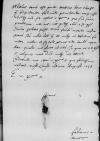Venit huc Filip Szczepanowski son of Erazm Szczepanowski; servant of Ioannes Dantiscus⌊SceppanowskiFilip Szczepanowski son of Erazm Szczepanowski; servant of Ioannes Dantiscus⌋ praeteritis diebus, qui Erazm Szczepanowski (†1538), at least in 1537 wójt of Biecz (KALETA, p. 97; BUJAK, p. 66)⌊patremErazm Szczepanowski (†1538), at least in 1537 wójt of Biecz (KALETA, p. 97; BUJAK, p. 66)⌋ suum X horis tantum vivum vidit, quo mortuo cogitur funebralia curare, cum solus domi sit. Quare Vestram Reverendissimam Dominationem supplicat, dignetur boni consulere ipsius tardiorem reditum. Absolutis autem negotiis suis post festum sancti Michaelis dicit se rediturum.
Interim his censui Vestrae Reverendissimae Dominationi significandum de singulis. Facit hoc idem dominus Eychler de equis, ut ei commissum est, et infra 10 dies scribemus plura per quendam Gregorium Pwff de Munsterberg, qui se consanguineum et servum Vestrae Reverendissimae Dominationis esse dicit.
Cum domino Samuel Maciejowski (*1499 – †1550), humanist and diplomat, one of the most trusted advisors to King Sigismund I and then to his son Sigismund II Augustus; from 1521 Canon of the Collegiate Chapter in Sandomierz, and from 1530 in Kielce; from 1531 Canon of Gniezno; from 1532 or 1533 to 1537 royal secretary (previously scribe at the royal chancellery); 1537-1539 Grand Secretary; 1539-1547 Crown Vice-Chancellor; 1539-1541 Bishop of Chełm; 1541-1545 Bishop of Płock; 1545-1550 Bishop of Cracow; 1547-1550 Crown Grand Chancellor; in 1532 royal envoy to Rome; in 1534 and 1538 royal envoy to the local diets (WYCZAŃSKI 1990, p. 257-258; Urzędnicy 10, p. 184; PSB 19 Machowski - Maria Kazimiera, p. 64-69)⌊Samuele MaczyeyewskiSamuel Maciejowski (*1499 – †1550), humanist and diplomat, one of the most trusted advisors to King Sigismund I and then to his son Sigismund II Augustus; from 1521 Canon of the Collegiate Chapter in Sandomierz, and from 1530 in Kielce; from 1531 Canon of Gniezno; from 1532 or 1533 to 1537 royal secretary (previously scribe at the royal chancellery); 1537-1539 Grand Secretary; 1539-1547 Crown Vice-Chancellor; 1539-1541 Bishop of Chełm; 1541-1545 Bishop of Płock; 1545-1550 Bishop of Cracow; 1547-1550 Crown Grand Chancellor; in 1532 royal envoy to Rome; in 1534 and 1538 royal envoy to the local diets (WYCZAŃSKI 1990, p. 257-258; Urzędnicy 10, p. 184; PSB 19 Machowski - Maria Kazimiera, p. 64-69)⌋ locutus sum de articulis confirmandis. Qui dicit Sigismund I Jagiellon (Zygmunt I) (*1467 – †1548), King of Poland and Grand Duke of Lithuania (1506-1548); Duke of Głogów (Glogau) (1499-1506), Duke of Opava (1501-1506), Governor of Silesia (1504-1506); son of King Kazimierz IV Jagiellon and Elisabeth of Austria⌊maiestatem regiamSigismund I Jagiellon (Zygmunt I) (*1467 – †1548), King of Poland and Grand Duke of Lithuania (1506-1548); Duke of Głogów (Glogau) (1499-1506), Duke of Opava (1501-1506), Governor of Silesia (1504-1506); son of King Kazimierz IV Jagiellon and Elisabeth of Austria⌋ annuisse, ut confirmentur, sed praeter Marienburg (Malbork), town and castle in northern Poland, Pomeranian Voivodeship, on the Nogat river, a branch of the Vistula at its delta, the capital of the Grand Masters of the Teutonic Order in Prussia (1309-1457), a voivodeship capital in Royal Prussia, which belonged to the Kingdom of Poland (1466-1772). Marienburg (taking turns with Graudenz (Grudziądz)) was the venue for the Provincial Diets of Royal Prussia, which were chaired by the bishop of Ermland (Warmia)⌊MarieburgumMarienburg (Malbork), town and castle in northern Poland, Pomeranian Voivodeship, on the Nogat river, a branch of the Vistula at its delta, the capital of the Grand Masters of the Teutonic Order in Prussia (1309-1457), a voivodeship capital in Royal Prussia, which belonged to the Kingdom of Poland (1466-1772). Marienburg (taking turns with Graudenz (Grudziądz)) was the venue for the Provincial Diets of Royal Prussia, which were chaired by the bishop of Ermland (Warmia)⌋. Super hoc cupit cum primis certior fieri, alioqui omnia stabunt ad conventum usque.
Nova haec sunt et creduntur: Charles V of Habsburg (*1500 – †1558), ruler of the Burgundian territories (1506-1555), King of Spain as Charles I (1516-1556), King of Naples and Sicily, King of the Romans (1519-1530), Holy Roman Emperor of the German Nation (elected 1519, crowned 1530, abdicated 1556); son of Philip I the Handsome and Joanna the Mad of Castile⌊caesaremCharles V of Habsburg (*1500 – †1558), ruler of the Burgundian territories (1506-1555), King of Spain as Charles I (1516-1556), King of Naples and Sicily, King of the Romans (1519-1530), Holy Roman Emperor of the German Nation (elected 1519, crowned 1530, abdicated 1556); son of Philip I the Handsome and Joanna the Mad of Castile⌋ cum Francis I of Valois (*1494 – †1547), 1515-1547 King of France; son of Charles, Count of Angoulême, and Louise of Savoy⌊GalloFrancis I of Valois (*1494 – †1547), 1515-1547 King of France; son of Charles, Count of Angoulême, and Louise of Savoy⌋ amicissimos factos; in reditu Paul III (Alessandro Farnese) (*1468 – †1549), 1493 elevated to cardinal; 1524 Cardinal-Bishop of Ostia; 1534-1549 Pope⌊summi pontificisPaul III (Alessandro Farnese) (*1468 – †1549), 1493 elevated to cardinal; 1524 Cardinal-Bishop of Ostia; 1534-1549 Pope⌋ ex Nice (Nizza, Nicaea), town and port on the southeastern coast of France, between Marseille and Genoa, from 1388 belonging to the counts and subsequently (from the 15th century) to the dukes of Savoy⌊NissaNice (Nizza, Nicaea), town and port on the southeastern coast of France, between Marseille and Genoa, from 1388 belonging to the counts and subsequently (from the 15th century) to the dukes of Savoy⌋ Rome (Roma), city in central Italy, on the Tiber river, seat of the Holy See⌊RomamRome (Roma), city in central Italy, on the Tiber river, seat of the Holy See⌋ piratae ceperunt aliquot navigia, quibus vehebantur multa eius bona, etc.
 BCz, 1599, p. 92
BCz, 1599, p. 92
27 huius rediit huc incolumis serenissimus Sigismund II Augustus Jagiellon (Zygmunt II August) (*1520 – †1572), 1529-1572 Grand Duke of Lithuania (ruled from 1544); 1530-1572 King of Poland (crowned vivente rege (ruled from 1548, after the death of his father); son of Sigismund I Jagiellon and Bona Sforza⌊rex iuvenisSigismund II Augustus Jagiellon (Zygmunt II August) (*1520 – †1572), 1529-1572 Grand Duke of Lithuania (ruled from 1544); 1530-1572 King of Poland (crowned vivente rege (ruled from 1548, after the death of his father); son of Sigismund I Jagiellon and Bona Sforza⌋, arma hidden by binding⌈[a]a hidden by binding⌉tus cum omnibus suis, quod antea a nostratibus non visum. Dominus Jan Tarnowski (*1488 – †1561), Count of the Holy Roman Empire; one of the most trusted advisors to King Sigismund August Jagiellon at the beginning of his rule; 1522-1527 Castellan of Wojnicz, 1525-1552 Starost of Sandomierz, 1527-1559 Grand Crown Hetman (commander-in-chief), 1527-1535 voivode of Ruthenia, 1528 Starost of Żydaczów, 1535-1536 Voivode of Cracow; 1536-1561 - Castellan (Urzędnicy 10, p. 209)⌊TarnowskiJan Tarnowski (*1488 – †1561), Count of the Holy Roman Empire; one of the most trusted advisors to King Sigismund August Jagiellon at the beginning of his rule; 1522-1527 Castellan of Wojnicz, 1525-1552 Starost of Sandomierz, 1527-1559 Grand Crown Hetman (commander-in-chief), 1527-1535 voivode of Ruthenia, 1528 Starost of Żydaczów, 1535-1536 Voivode of Cracow; 1536-1561 - Castellan (Urzędnicy 10, p. 209)⌋ cum exercitu ingressus est nemine obstan hidden by binding⌈[n]n hidden by binding⌉te Duchy of Moldavia (Valachia, Hospodarstwo Mołdawskie), country between the eastern Carpathians, the Dniester and the Danube delta, from 1456 a fiefdom of Turkey, where Polish and Turkish influences clashed in the 15th-16th centuries. The Latin name Valachia was widely used in Poland at the time to describe Moldavia, and not the Duchy of Wallachia, which was further south⌊VallachiamDuchy of Moldavia (Valachia, Hospodarstwo Mołdawskie), country between the eastern Carpathians, the Dniester and the Danube delta, from 1456 a fiefdom of Turkey, where Polish and Turkish influences clashed in the 15th-16th centuries. The Latin name Valachia was widely used in Poland at the time to describe Moldavia, and not the Duchy of Wallachia, which was further south⌋, ubi munitissimum castrum Chocim⌊ChoczymChocim⌋ oppug hidden by binding⌈[ug]ug hidden by binding⌉nat. Primo accursu ceciderunt ex nostris 5 milites. Dominus Mikołaj Iskrzycki (*ca. 1480 – †1540), participant in the battle of Orsza; commander of the troops (rotmistrz) of the permanent defense force (obrona potoczna); 1513 pantler of Kamieniec; 1530 chamberlain of Kamieniec; 1534 starosta of Śniatyń; 1536 - of Kamieniec⌊IskrzyckiMikołaj Iskrzycki (*ca. 1480 – †1540), participant in the battle of Orsza; commander of the troops (rotmistrz) of the permanent defense force (obrona potoczna); 1513 pantler of Kamieniec; 1530 chamberlain of Kamieniec; 1534 starosta of Śniatyń; 1536 - of Kamieniec⌋ globulo in altero brachio vulnus accepit. Pulveris multum absumptum est et tormentis aliquot ruptis, muri tamen firmi remanent, sunt enim, ut licet ex frusto allato videre, structi ex gypso et hidden by binding⌈[o et]o et hidden by binding⌉ caemento durissimo, ut alias Pozzuoli (Puteoli)⌊PuteolisPozzuoli (Puteoli)⌋ et in Kingdom of Aragon (Aragonia), region in northeastern Spain, until 1479 the Kingdom of Aragon⌊Regno ArragoniaeKingdom of Aragon (Aragonia), region in northeastern Spain, until 1479 the Kingdom of Aragon⌋ vidimus.
Cras serenissimi Sigismund I Jagiellon (Zygmunt I) (*1467 – †1548), King of Poland and Grand Duke of Lithuania (1506-1548); Duke of Głogów (Glogau) (1499-1506), Duke of Opava (1501-1506), Governor of Silesia (1504-1506); son of King Kazimierz IV Jagiellon and Elisabeth of Austria
Bona Sforza (*1494 – †1557), Queen of Poland and Grand Duchess of Lithuania (1518-1557); the second wife of Sigismund I Jagiellon; Duchess of Bari and Rossano; daughter of Gian Galeazzo Sforza of Milan and Isabella of Aragon⌊principes nostriSigismund I Jagiellon (Zygmunt I) (*1467 – †1548), King of Poland and Grand Duke of Lithuania (1506-1548); Duke of Głogów (Glogau) (1499-1506), Duke of Opava (1501-1506), Governor of Silesia (1504-1506); son of King Kazimierz IV Jagiellon and Elisabeth of Austria
Bona Sforza (*1494 – †1557), Queen of Poland and Grand Duchess of Lithuania (1518-1557); the second wife of Sigismund I Jagiellon; Duchess of Bari and Rossano; daughter of Gian Galeazzo Sforza of Milan and Isabella of Aragon⌋ abeunt in Niepołomice, town in southern Poland, Małopolska, on the Vistula river, on the edge of a big forest called Puszcza Niepołomicka, 25 km E of Cracow, residence of Polish kings of Jagiellon dynasty; favourite place of royal huntings⌊NiepolomiczeNiepołomice, town in southern Poland, Małopolska, on the Vistula river, on the edge of a big forest called Puszcza Niepołomicka, 25 km E of Cracow, residence of Polish kings of Jagiellon dynasty; favourite place of royal huntings⌋ venatum hidden by binding⌈[um]um hidden by binding⌉ septima die redituri.
De The Ottoman Turks (Turcae) ⌊TurcisThe Ottoman Turks (Turcae) ⌋ nil novi habetur, mirum. Similiter ex Italy (Italia)⌊ItaliaItaly (Italia)⌋ scribitur.
Quantum ad rem meam pertinet, ago summas gratias Vestrae Dominationi hidden by binding⌈[Dominationi]Dominationi hidden by binding⌉ Reverendissimae, quod me ad meliora pie hortatur auxiliumque offert hidden by binding⌈[ert]ert hidden by binding⌉. Ego semina mea praeteritis annis iacta puto in fertilissimos campos. Exspecto fatum meum cum fructu, sed rusticus exspectat, dum defluat amnis. At ille labitur hidden by binding⌈[ur]ur hidden by binding⌉ et labetur in omne volubilis aevum.  BCz, 1599, p. 93 Melius tamen esse puto tardius bene elegisse, quam praecipitanter festinando poenitenda arripuisse. Utcumque autem sit, credat Vestra Reverendissima Dominatio pro sua summa prudentia nec me, nec quemquam alium a se ipso similia habere posse.
BCz, 1599, p. 93 Melius tamen esse puto tardius bene elegisse, quam praecipitanter festinando poenitenda arripuisse. Utcumque autem sit, credat Vestra Reverendissima Dominatio pro sua summa prudentia nec me, nec quemquam alium a se ipso similia habere posse.
Dominus secundum merita nostra gratiam suam nobis dat. Quam et mihi non defuturam firmiter credo, ut scilicet tale genus vitae tandem ingrediar, quale me ducet ad vitam. In qua re Vestra Dominatio Reverendisisma cum reliquis meis dominis mihi non deerit.
Commendo me iterum Vestrae Reverendissimae Dominationi.
Quae felicissime valeat.
 BCz, 1599, p. 93 Melius tamen esse puto tardius bene elegisse, quam praecipitanter festinando poenitenda arripuisse. Utcumque autem sit, credat Vestra Reverendissima Dominatio pro sua summa prudentia nec me, nec quemquam alium a se ipso similia habere posse.
BCz, 1599, p. 93 Melius tamen esse puto tardius bene elegisse, quam praecipitanter festinando poenitenda arripuisse. Utcumque autem sit, credat Vestra Reverendissima Dominatio pro sua summa prudentia nec me, nec quemquam alium a se ipso similia habere posse.



